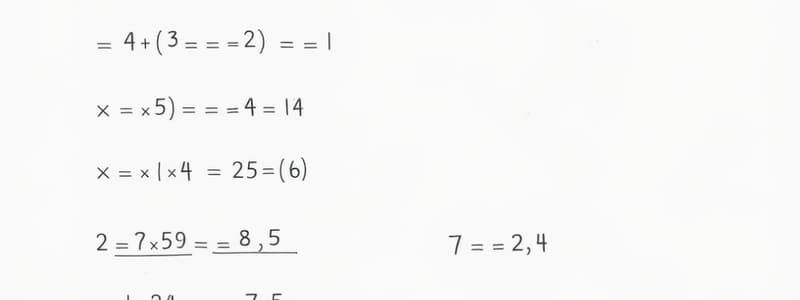Podcast
Questions and Answers
What is the first step to evaluate the expression $3x + 5$ when $x = 2$?
What is the first step to evaluate the expression $3x + 5$ when $x = 2$?
- Exponents
- Substitution (correct)
- Simplification
- Order of Operations
Nonnegative rational numbers can include negative integers.
Nonnegative rational numbers can include negative integers.
False (B)
What does the variable 'a' represent in the definition of nonnegative rational numbers?
What does the variable 'a' represent in the definition of nonnegative rational numbers?
An integer in the fraction (\frac{a}{b})
The expression $2 + \frac{1}{2}$ evaluates to _______.
The expression $2 + \frac{1}{2}$ evaluates to _______.
Match the following types of numbers with their characteristics:
Match the following types of numbers with their characteristics:
Flashcards are hidden until you start studying
Study Notes
Evaluating Expressions
-
Definition: The process of calculating the value of an expression by substituting variables with numbers.
-
Steps to Evaluate:
- Substitution: Replace each variable in the expression with the given value.
- Order of Operations: Follow PEMDAS/BODMAS rules:
- Parentheses/Brackets
- Exponents/Orders
- Multiplication and Division (from left to right)
- Addition and Subtraction (from left to right)
- Simplification: Perform the operations to simplify the expression to a single numerical value.
-
Example: Evaluate (3x + 5) when (x = 2).
- Substitute: (3(2) + 5)
- Calculate: (6 + 5 = 11)
Nonnegative Rational Numbers
-
Definition: Numbers that can be expressed as a fraction (\frac{a}{b}) where:
- (a) and (b) are integers
- (b \neq 0)
- (a \geq 0) (ensures nonnegativity)
-
Characteristics:
- Includes whole numbers and positive fractions.
- Examples: (0, \frac{1}{2}, 3, 4.75)
-
Properties:
- Closure: Nonnegative rational numbers are closed under addition and multiplication.
- Ordering: Nonnegative rational numbers can be ordered on a number line where (0) is the smallest.
- Density: Between any two nonnegative rational numbers, there exists another nonnegative rational number.
-
Operations:
- Addition: (\frac{a}{b} + \frac{c}{d} = \frac{ad + bc}{bd})
- Multiplication: (\frac{a}{b} \times \frac{c}{d} = \frac{ac}{bd})
-
Applications:
- Used in various fields such as finance, engineering, and everyday calculations involving ratios and proportions.
Evaluating Expressions
- Expression Evaluation: Involves determining the value of an expression by substituting variables with specific numerical values.
- Evaluation Steps:
- Substitution: Each variable in the expression is replaced by its respective value.
- Order of Operations: Follow PEMDAS/BODMAS rules to maintain correct calculation order:
- Parentheses/Brackets first
- Then Exponents/Orders
- Followed by Multiplication and Division (left to right)
- Finally, Addition and Subtraction (left to right)
- Simplification: Execute the operations from above to condense the expression to a final numerical value.
- Example Illustration: For the expression (3x + 5) with (x = 2):
- Substitute to get (3(2) + 5)
- Calculate to achieve (11)
Nonnegative Rational Numbers
- Definition: Nonnegative rational numbers are numbers that can be represented as the fraction (\frac{a}{b}), where:
- (a) (numerator) and (b) (denominator) are integers
- (b) cannot be (0)
- (a) must be greater than or equal to (0) to ensure the number is nonnegative.
- Characteristics:
- Consist of whole numbers and positive fractions.
- Examples include (0, \frac{1}{2}, 3,) and (4.75).
- Properties:
- Closure Property: Nonnegative rational numbers maintain closure under both addition and multiplication; combining these numbers keeps the result within this set.
- Ordering: They can be arranged on a number line, with (0) being the least value.
- Density: For any two nonnegative rational numbers, another nonnegative rational number can always be found in between them.
- Operations:
- Addition: When adding two nonnegative rational numbers, (\frac{a}{b} + \frac{c}{d}) results in (\frac{ad + bc}{bd}).
- Multiplication: When multiplying two nonnegative rational numbers, (\frac{a}{b} \times \frac{c}{d}) results in (\frac{ac}{bd}).
- Applications: Nonnegative rational numbers are essential in finance, engineering, and daily calculations involving ratios and proportions.
Studying That Suits You
Use AI to generate personalized quizzes and flashcards to suit your learning preferences.




